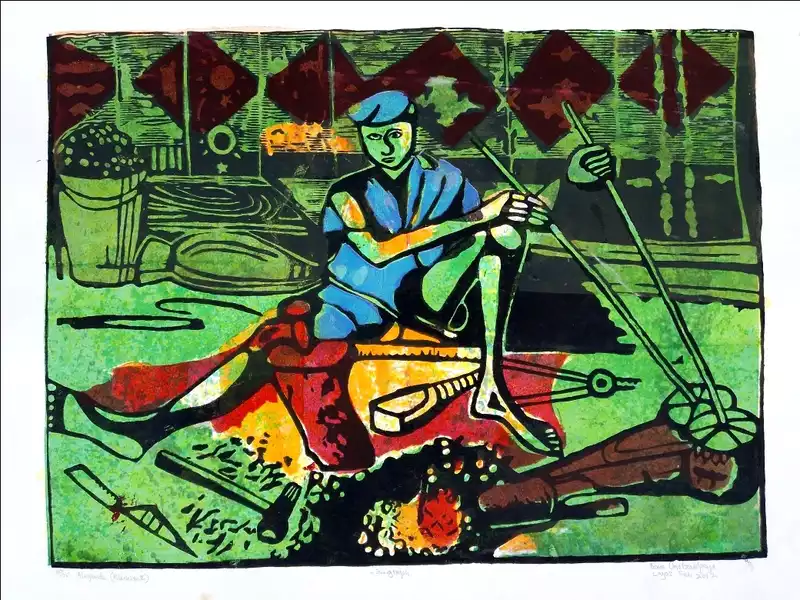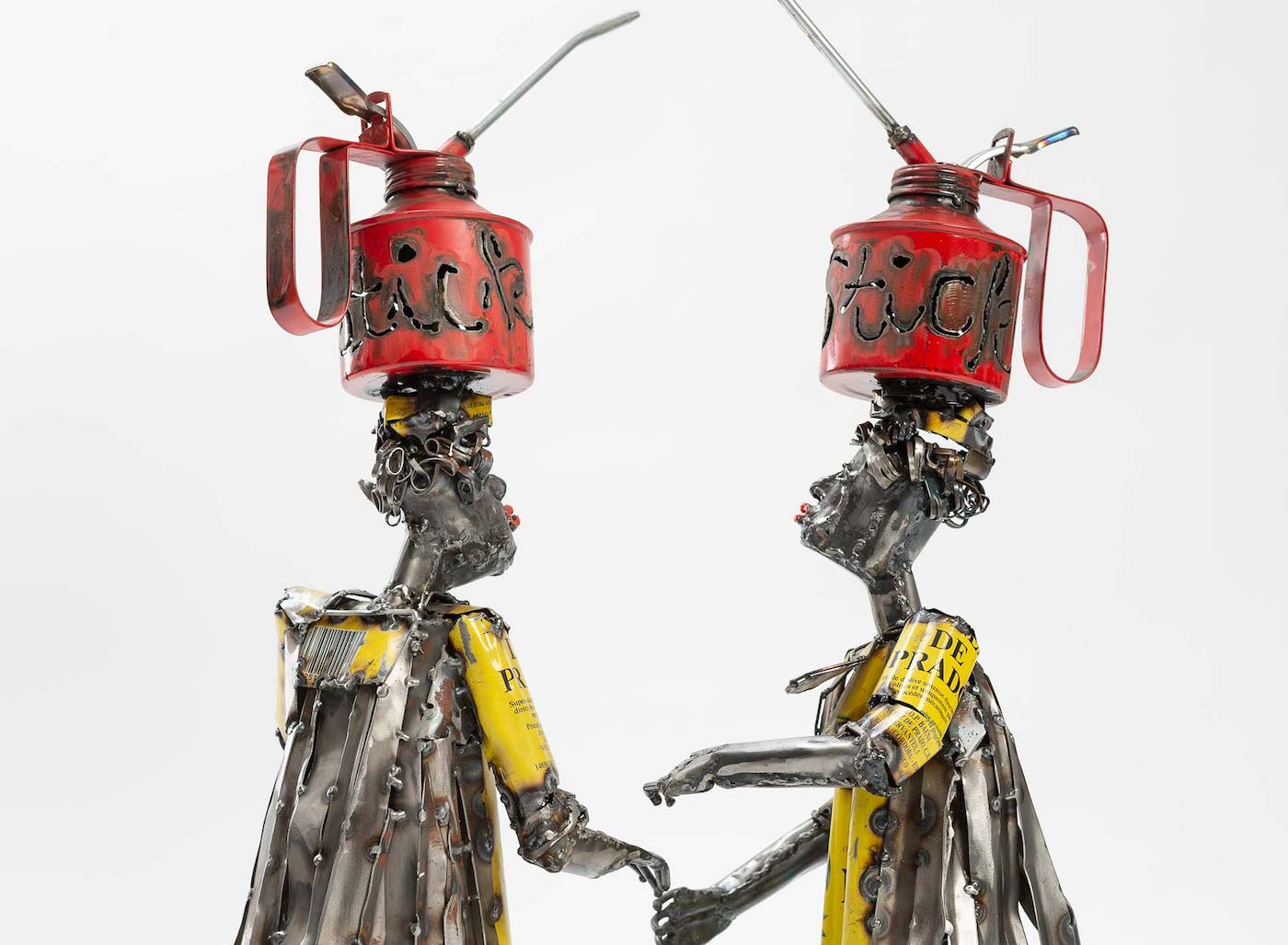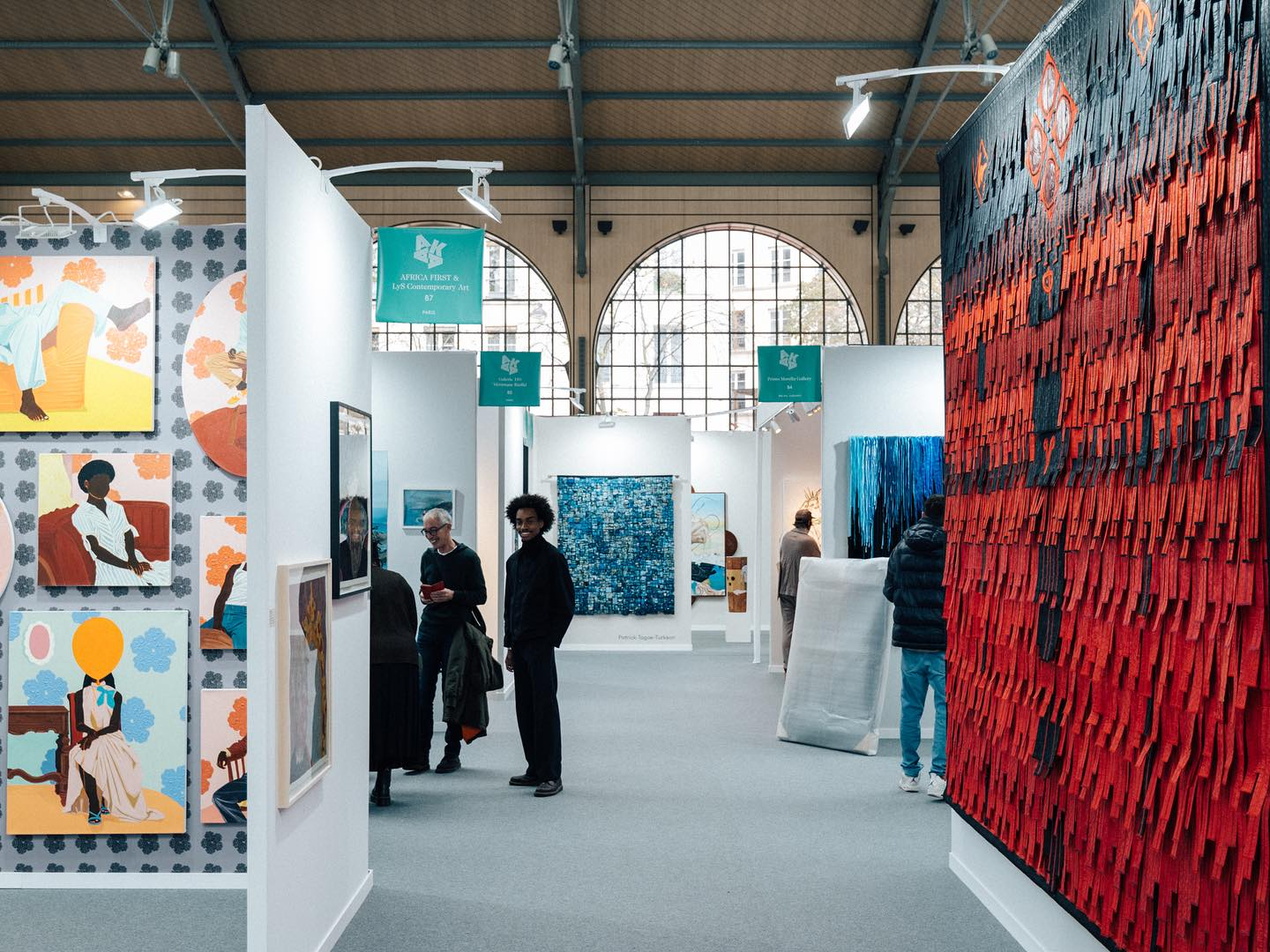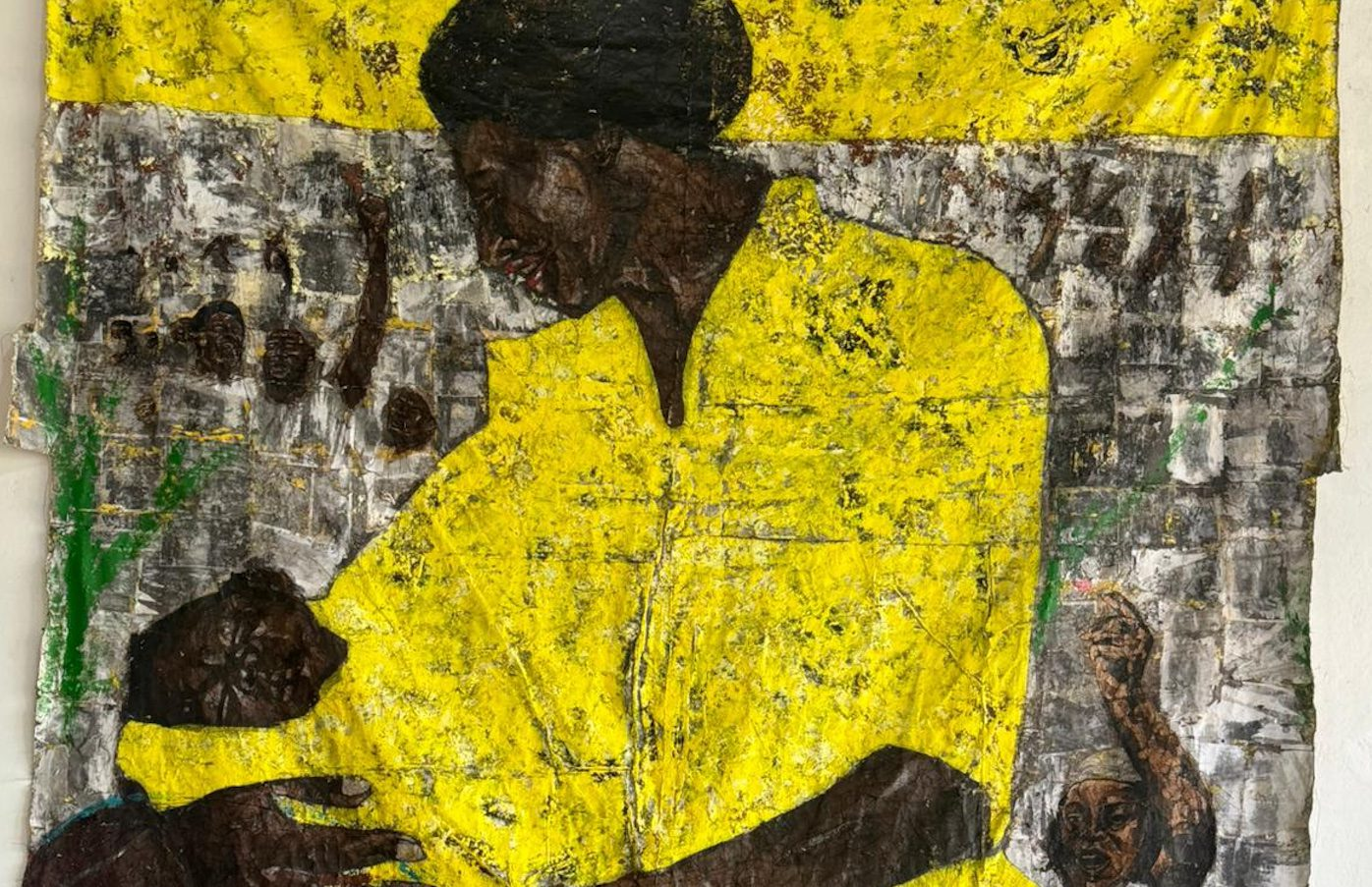Orry Shenjobi’s multi-layered exploration of the importance of community is an immersive one as she delves into the stories of people from diverse communities. Passionate about history, and documentation, she is using a diverse range of materials and intricately layered techniques to weave personal narratives from the stories of people from communities she has experienced. Shenjobi is particular about the materials that she explores in her work as they go beyond sustainability and tell stories of their own.

Orry Shenjobi (b. 1997), raised in London and Lagos, is a multi-disciplinary artist whose works transcend the boundaries of conventional artistic expression. She is the Creative Director of Studio ORRY. With a degree in Product Design from the University of Leeds and an MA in Social Innovation and Sustainable Futures from UAL, Shenjobi brings a unique blend of creativity and social consciousness to her art. Her work art reflects the fusion of the dynamic scenes of Lagos and London, which influences her versatile repertoire from paintings to tapestries. Shenjobi’s work delves into individualistic identity and community dynamics, capturing everyday life within diverse communities. Her art, infused with photorealism, merges photography seamlessly to create distinctive characters and scenes, radiating vibrancy and depth.
In a conversation with Omenai, Shenjobi talks about her artistic processes, “A wà ńbẹ̀”, her upcoming solo show in collaboration with the European Cultural Centre for its “Personal Structures” presentation during the 60th Venice Biennale, and the importance of collaborations.
How would you describe yourself and your work?
OS: I consider myself a visionary. I am very meticulous in my work as well. I’m someone who loves to push boundaries, challenge myself, and challenge those around me. My work is community-focused, championing where I’m from and the importance of community. I love to champion my people and what we stand for. There’s so much that has been eroded from our history just because of the lack of documentation and preservation of archives. As someone who deeply believes that if you don’t have a point of reference or a blueprint, it’s difficult to advance, then you are kind of just walking around in circles. Since I started, my work has always been community-based, and it has gotten even stronger living away from home. Day-to-day living here can be very isolating and it made me crave community a lot more.
What does your artistic creative process look like?
OS: I started as a traditional oil painter. I started combining photography with paint and fabric when I was studying arts for my A-levels in school. When I have an idea, theme, or subject that I am interested in exploring, I research, and then I hit the streets to shoot. The work gets a bit more interesting when I’m combining the mediums. Once I have selected, edited, and cleaned my photographs, which doesn’t require a crazy editing process because I like them to be as raw as possible, not to subdue the story behind it. Postproduction, for my paintings, I select again. Not every photograph turns into a painting. I select the ones that I feel have a bigger story to tell there. Next is my mixed media practice. My mixed-media practice is extremely laborious. It can be painful at times and it takes a while. There are different elements, and different collections have different mixes of media. For example, I can do collections that are just tapestry-based, heavily painting-based, mixed tapestries, mixed paintings, mixed sustainable materials, or recycled materials. It just depends on what that image calls for. I sit with my work before I paint or embellish it with thread or embroidery. I actually sit with the work, and it feels like I have a conversation with it. What do you need? How would you like to be portrayed? I ask these questions to the work and the work answers. I marinate over the work and there’s a ping in my head that the dots connect. I can see the work finally. It might sound strange, but it shows me exactly where things can be: a pair of trousers or a shirt. It’s like a ping. When you’re playing pinball or something and the ball goes off and it’s like ding ding ding, that’s how it is. I just started seeing all the dots connect. Sometimes it doesn’t come out exactly the way it should.

What do you do when a piece doesn’t work out? Since your work starts with photography, can’t you just print out another one?
OS: That’s what people think. They think there is space for errors. It is not because of the photograph or the symmetry. Unlike an oil painting, where it all begins on a blank canvas, and if you mess up, nobody knows except you, a photograph is already set. I can’t just reprint and start again as it is very costly. To fix it, you need to go over it again, and basically reconstruct and this requires outside-the-box thinking, like: How can I push it into another dimension?
Can you highlight the recurring theme(s) in your work?
OS: Community, resilience, beauty, togetherness, pride, curiosity, exploration and adoration. I feel like there’s just so much going on all the time, and my art is a safe space. It’s what I do, what I enjoy. It’s how I switch off. You know, and I think everybody needs that in some form. If you actually dig deep into the work, there are some statements, albeit subtle, where I say ‘post-no-bill’, or ‘this house is not for sale’, ‘beware of 419’ to show advance-fee scams which are also real problems.
Let’s talk about your upcoming solo exhibition in collaboration with the European Cultural Centre for its “Personal Structures’’ presentation during the 60th Venice Biennale. First, how does it feel to be an exhibiting artist at this year’s edition of the Venice Biennale?
OS: It’s a very humbling experience, and I say that in a good way. Not only have I learned a lot about myself and my culture, among other things, but I also feel very honored and blessed to be fortunate to participate and to make my people proud. Where I’m from, like I said, is very important to me. Being able to make them proud and shed light on how beautiful our culture has been a good and humbling experience.

Foreigners Everywhere, the theme of the 60th Venice Biennale, is a celebration of the “foreign, the distant, the outsider, the queer, as well as the indigenous.” In line with the theme, what inspired the body of work, “A wà ńbẹ̀: A Celebration of Community and Culture?”
OS: It’s so crazy how everything just kind of aligns with the theme. A wà ńbẹ̀ means ‘we are there.’ It’s a statement. Fun fact, I worked on this collection for a year before the title finally came to me. Tentatively, it was just called ‘Ówámbẹ̀’ until the time came to crown it. Owambe just felt so generic and I wasn’t feeling it. I was throwing around a few phrases, and I said, you know what? I want the collection to say, you know, we have arrived. Then one of my friends just said, “A wà ńbè now,” which means we are there. It was more than just a play on words as we are actually going to be there; shining a light on the culture.
A wà ńbẹ̀ is a solo show, but it is also a collaborative effort. I’m neither a sound designer, a textile designer, a scriptwriter, nor a video editor. I had to collaborate with people to get these things done. It’s a communal exercise. You know, to put Alagas on, it’s not just the event planner by themselves. It’s the Alagas, the drummers, the musicians, the waiters, and the Alagas. Everybody is involved, down to the tailor in your backyard sewing your dress or your fila. Everything just came together and aligned with the theme. We are foreigners everywhere and a wà ńbè. You can’t miss us.
How did you come up with the idea for the show?
OS: I was in Venice for a show in 2022. I was at an art fair, and I visited some exhibition booths at the Biennale. I went around, and there was just something missing. The art was beautiful. Diverse people and institutions were presenting; everybody did a great job but something was missing. I feel like there is a vibe we carry as Nigerians. I didn’t feel represented. Even though black people were exhibiting, it wasn’t the same. I was like, “This is a great production, but we need to be here. Why are we not here?” Because I firmly believe that wherever we are, we show up and we show out. That’s one of our strengths. When I went back and thought about it, I saw an artist from Ecuador. He was exhibiting at the time, and his space was an ode to Cocoa Production. Cocoa is big in Ecuador too. So, his whole presentation was tied to the production of cocoa. Once you stepped into his room, it felt like you were stepping into the Ecuadorian forest with cocoa farmers. Even to the smell. I loved how immersive the experience was. It was very different from the normal white walls—just paintings, photographs, whatever they may be. So, I went back, and things were just flying in my head from this experience. I just opened my mouth and said, “I just want us to have a party. Let’s just have a party in this place.” Why not?
Tell me what ‘A wà ńbè’, the presentation consists of.
OS: From film, installation, textile, sound, and smell, A wà ńbè is a full production. This is my first film. This is also the first time I’m showing only photography in an exhibition. It is exactly how I described it in the very beginning, in 2022. I said to the curator, Usen Esiet, “I want this to be an immersive experience where people can step into the room and feel like they’ve left Venice and have been transported to Lagos.” I know it can’t be the same as it’s not an actual owanbe party; it’s a show but I want people to experience my culture. Certain things were off-limits like food, unfortunately, because of preservation as it is a long show. We can’t preserve a lot, but there would be sweet smells. For textiles, I wanted people to not only see the clothes like agbada and gele that people wear to events like this but to imagine how regal they would feel in them.
Does that mean that there will be sounds taken from current or popular Owambe songs?
OS: We’ve made a specific sound design for this. With the sound, I wanted people to hear what it would sound like if they happened to have the opportunity to experience this in real life. We translated it culturally so it could be packaged as a show, rather than as a party. So, that’s quite the experience. I mean, it has been a very intense year and a half.
What are you looking forward to working on after A wà ńbẹ̀?
OS: I have several projects I’m working on now. I’m always working. I’m like a studio rat. To me, it’s not even work. I just love to do it. I’m obsessed. This body of work, in particular, that will be presented at the biennale doesn’t just stop there. There are a lot of pieces that didn’t make it to the biennale because they were so strong as a subsection and they can stand alone as a show by themselves. I hope to do things with them throughout the year. I want this to just be like the A wà ńbẹ̀ year. There are some bangers in the arsenal that I hope, by God’s grace, I’m able to show in between Venice.
Are you a full-time artist?
OS: I’m a full-time artist. I wasn’t always a full-time artist, but I was like, “What’s this?” You know. I am so happy that I gave in and listened because I can’t imagine doing anything else.
Iyanuoluwa Adenle is a Nigerian art writer, essayist, and poet based in Lagos. She is currently the head writer at Omenai. Adenle has contributed to a number of art publications, including Tender Photo, Art News Africa, Pavillon 54, and Omenai.






